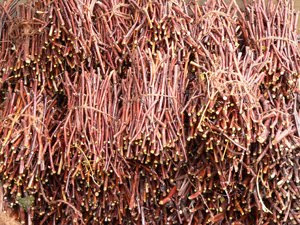Any Vineyard's major challenge lies in controlling the pest/fungal attacks that occurs at regular intervals. This needs to be controlled at the right moment, which otherwise can directly effect the quality of grapes.
FOLIAGE SPRAYS:
Yellow Rust and Downy Mildew(which often is a weather driven disease) are noticeable on foliage (leaves) and will need immediate attention, failing which entire Vineyards can get quickly affected.
In India, we generally use fertilizers Acrobat (1 gm/liter of water) and Polyram (2 gm/liter of water) to prevent the fungal attack.

To efficiently make sure that uniform spraying is done and in a quicker way - we use a POWER SPRAYER (3 HP Pump) which runs on kerosene and starts with petrol.

WEED CONTROL:
The weeds around a Vineyard is surely an eye-sore and more than that - plant food is mostly eaten by these unwanted shrubs. Here we generally get affected by Parthenium / Grass and old deep roots present in soil.
A proper maintenance especially around the Vine (Grape Plant) will make sure that enough nourishment is reaching them. We can either employ laborers to manually remove these weeds or use a POWER WEEDER (a 2.5 HP petrol run pump) to brush off the weeds.
Below is a classy view of 'before' and 'after' a power weeder has been used:

POWER TILLING the land helps us in helping the soil breathe easily. Secondly, it also removes old roots and avoids future growth of weeds, after a period of time.


Until then, this process of weed control must be strictly followed to ensure, high quality of grapes.


In India, we generally use fertilizers Acrobat (1 gm/liter of water) and Polyram (2 gm/liter of water) to prevent the fungal attack.

To efficiently make sure that uniform spraying is done and in a quicker way - we use a POWER SPRAYER (3 HP Pump) which runs on kerosene and starts with petrol.

WEED CONTROL:
The weeds around a Vineyard is surely an eye-sore and more than that - plant food is mostly eaten by these unwanted shrubs. Here we generally get affected by Parthenium / Grass and old deep roots present in soil.
A proper maintenance especially around the Vine (Grape Plant) will make sure that enough nourishment is reaching them. We can either employ laborers to manually remove these weeds or use a POWER WEEDER (a 2.5 HP petrol run pump) to brush off the weeds.
Below is a classy view of 'before' and 'after' a power weeder has been used:

POWER TILLING the land helps us in helping the soil breathe easily. Secondly, it also removes old roots and avoids future growth of weeds, after a period of time.


Until then, this process of weed control must be strictly followed to ensure, high quality of grapes.





















